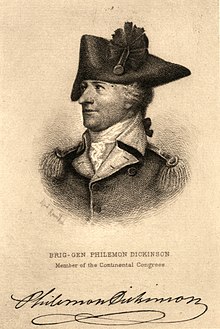| Forage War | |||||||
|---|---|---|---|---|---|---|---|
| Part of the American Revolutionary War | |||||||
 New Jersey militia commander Philemon Dickinson | |||||||
| |||||||
| Belligerents | |||||||
|
|
| ||||||
| Commanders and leaders | |||||||
|
George Washington William Maxwell Philemon Dickinson |
Charles Mawhood Johann Ewald | ||||||
| Strength | |||||||
| Thousands of militia, several companies of regulars | 10,000 (New Jersey garrison size)[1] | ||||||
| Casualties and losses | |||||||
| Unknown | At least 954 killed, wounded or captured[2] | ||||||
The Forage War was a partisan campaign consisting of numerous small skirmishes that took place in New Jersey during the American Revolutionary War between January and March 1777, following the battles of Trenton and Princeton. After both British and Continental Army troops entered their winter quarters in early January, Continental Army regulars and militia companies from New Jersey and Pennsylvania engaged in numerous scouting and harassing operations against the British and German troops quartered in New Jersey.
The British troops wanted to have fresh provisions to consume, and also required fresh forage for their draft animals and horses. General George Washington ordered the systematic removal of such supplies from areas easily accessible to the British, and companies of American militia and troops harassed British and German forays to acquire such provisions. While many of these operations were small, in some cases they became quite elaborate, involving more than 1,000 troops. The American operations were so successful that British casualties in New Jersey (including those of the battles at Trenton and Princeton) exceeded those of the entire campaign for New York.